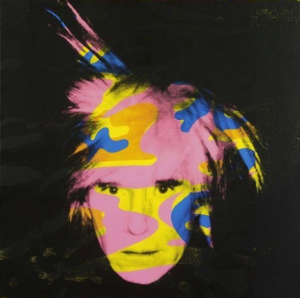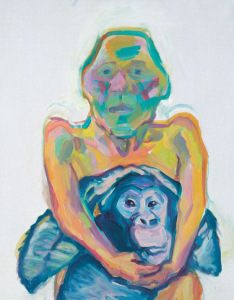“The most exciting attractions are between two opposites that never meet.”
– Andy Warhol

“An artist is somebody who produces things that people don’t need to have.”
– Andy Warhol
Camouflage self-portrait (1968)
We rarely think about how daring and provocative people already were half a century ago. My aim is to challenge this and show you, through the art of Andy Warhol and Maria Lassnig, the boldness artists exhibited within the field of visual arts in the mid-20th century. I was lucky enough to see the works of these two artists in person, and they had a deep impact on me, some of which I would like to share here with you. First I’ll walk you through the differences between Warhol’s and Lassnig’s art and then move on to their similarities.
Andy Warhol, after graduating from college, landed a freelancing job with Glamour and went on to produce dozens of commissioned illustrations for such prominent publications as Esquire, Mademoiselle, and McCall’s – with such a start in the world of art, it’s no wonder Warhol became one of the most famous artists of the ’50s. Maria Lassnig, on the other hand, is not really a well-known painter, even though her works are just as remarkable. Warhol started his career with loose, blotted-ink style paintings, influenced mainly by the avant-garde movement; this innovative style earned his designs praise as “whimsical” and was recognized with several awards. Lassnig’s technique was mainly shaped by cubism, abstract style, and later surrealism.
In ’61, Warhol started to draw more attention to painting – that’s when he debuted his own style called “pop-art”. This is likely how most people know him – Warhol’s most famous paintings include celebrities and popular brands depicted in vivid colors.

“I do remember when it occurred to me the first time, when I got the idea of painting the way I feel at a given moment. I was sitting in a chair and felt it pressing against me. I still have the drawings where I depicted the sensation of sitting.” – Maria Lassnig
Self-portrait with a monkey (2001)
Lassnig only started to focus on the human body a decade later – which made her more well-known in the professional field. Instead of painting what she saw, Lassnig portrayed her sensations: that’s why we see figures with elongated limbs, pig’s noses and grimacing mouths.
But how could two artists who differ so much have anything in common? Well, you can notice a common element already on the “surface”: both Warhol and Lassnig preferred to use bright, vibrant colors.
However, the similarities between the two artists run deeper; their intentions and their goals should not be forgotten either. Unfortunately, these aspects are rarely considered when comparing the two, even though they show remarkable similarities. Both painters were heavily influenced by consumerism, which inspired them to make such dazzling portraits. Furthermore, they also had a purpose with their thought-provoking techniques: to express, moreover to criticize the society in their own, very original ways, the end-results of which function as distorted mirrors.
I hope that by this point, the connection between the quote I chose and the purpose of this article has become clear – there is a definite, palpable distance between Warhol’s and Lassnig’s works, but they still manage to “meet” in a way. They still succeed in being exciting, attractive, thought-provoking pieces of art that deserve to be remembered. That is also why I think they can give a lot: they offer us a fuller picture of the world and a broader viewpoint as long as we stay open, even to the unknown…
For more readings and sources, visit the following sites:
Andy Warhol’s page on The Art Story
“Andy Warhol’s Magazine Career, from Raggedy to Riches” by Michael Dooley
Maria Lassnig’s obituary by Christopher Masters
For the images used in this post and the thumbnail, see:
Camouflage self-portrait by Andy Warhol
Self-portrait with a monkey by Maria Lassnig
Self-portrait by Andy Warhol
Lady with Brain by Maria Lassnig


